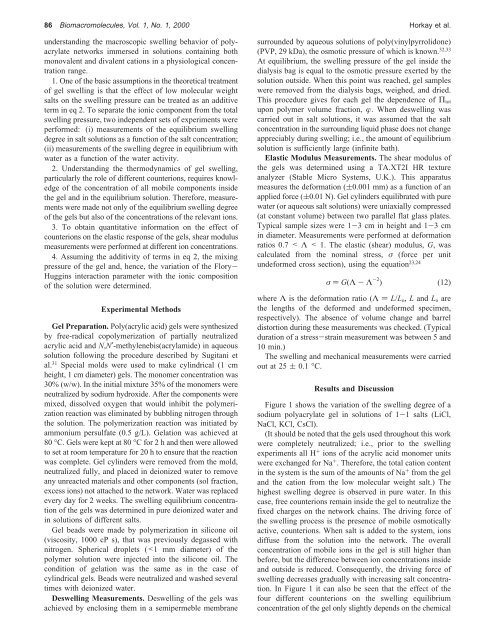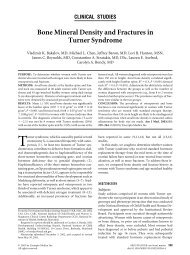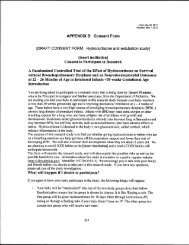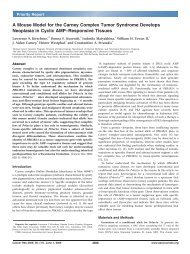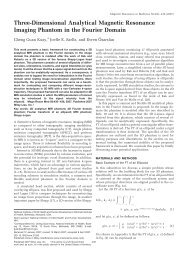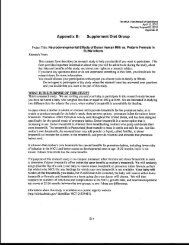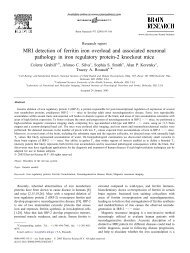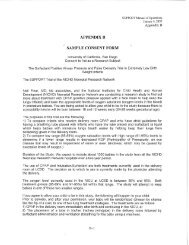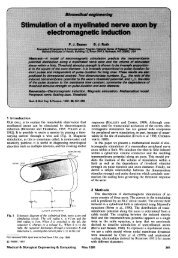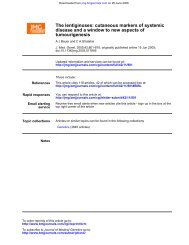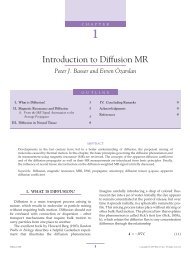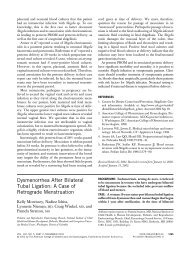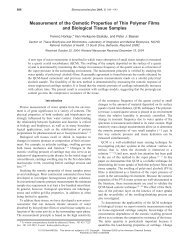Osmotic Swelling of Polyacrylate Hydrogels in Physiological Salt ...
Osmotic Swelling of Polyacrylate Hydrogels in Physiological Salt ...
Osmotic Swelling of Polyacrylate Hydrogels in Physiological Salt ...
You also want an ePaper? Increase the reach of your titles
YUMPU automatically turns print PDFs into web optimized ePapers that Google loves.
86 Biomacromolecules, Vol. 1, No. 1, 2000 Horkay et al.<br />
understand<strong>in</strong>g the macroscopic swell<strong>in</strong>g behavior <strong>of</strong> polyacrylate<br />
networks immersed <strong>in</strong> solutions conta<strong>in</strong><strong>in</strong>g both<br />
monovalent and divalent cations <strong>in</strong> a physiological concentration<br />
range.<br />
1. One <strong>of</strong> the basic assumptions <strong>in</strong> the theoretical treatment<br />
<strong>of</strong> gel swell<strong>in</strong>g is that the effect <strong>of</strong> low molecular weight<br />
salts on the swell<strong>in</strong>g pressure can be treated as an additive<br />
term <strong>in</strong> eq 2. To separate the ionic component from the total<br />
swell<strong>in</strong>g pressure, two <strong>in</strong>dependent sets <strong>of</strong> experiments were<br />
performed: (i) measurements <strong>of</strong> the equilibrium swell<strong>in</strong>g<br />
degree <strong>in</strong> salt solutions as a function <strong>of</strong> the salt concentration;<br />
(ii) measurements <strong>of</strong> the swell<strong>in</strong>g degree <strong>in</strong> equilibrium with<br />
water as a function <strong>of</strong> the water activity.<br />
2. Understand<strong>in</strong>g the thermodynamics <strong>of</strong> gel swell<strong>in</strong>g,<br />
particularly the role <strong>of</strong> different counterions, requires knowledge<br />
<strong>of</strong> the concentration <strong>of</strong> all mobile components <strong>in</strong>side<br />
the gel and <strong>in</strong> the equilibrium solution. Therefore, measurements<br />
were made not only <strong>of</strong> the equilibrium swell<strong>in</strong>g degree<br />
<strong>of</strong> the gels but also <strong>of</strong> the concentrations <strong>of</strong> the relevant ions.<br />
3. To obta<strong>in</strong> quantitative <strong>in</strong>formation on the effect <strong>of</strong><br />
counterions on the elastic response <strong>of</strong> the gels, shear modulus<br />
measurements were performed at different ion concentrations.<br />
4. Assum<strong>in</strong>g the additivity <strong>of</strong> terms <strong>in</strong> eq 2, the mix<strong>in</strong>g<br />
pressure <strong>of</strong> the gel and, hence, the variation <strong>of</strong> the Flory-<br />
Hugg<strong>in</strong>s <strong>in</strong>teraction parameter with the ionic composition<br />
<strong>of</strong> the solution were determ<strong>in</strong>ed.<br />
Experimental Methods<br />
Gel Preparation. Poly(acrylic acid) gels were synthesized<br />
by free-radical copolymerization <strong>of</strong> partially neutralized<br />
acrylic acid and N,N′-methylenebis(acrylamide) <strong>in</strong> aqueous<br />
solution follow<strong>in</strong>g the procedure described by Sugitani et<br />
al. 31 Special molds were used to make cyl<strong>in</strong>drical (1 cm<br />
height, 1 cm diameter) gels. The monomer concentration was<br />
30% (w/w). In the <strong>in</strong>itial mixture 35% <strong>of</strong> the monomers were<br />
neutralized by sodium hydroxide. After the components were<br />
mixed, dissolved oxygen that would <strong>in</strong>hibit the polymerization<br />
reaction was elim<strong>in</strong>ated by bubbl<strong>in</strong>g nitrogen through<br />
the solution. The polymerization reaction was <strong>in</strong>itiated by<br />
ammonium persulfate (0.5 g/L). Gelation was achieved at<br />
80 °C. Gels were kept at 80 °C for 2 h and then were allowed<br />
to set at room temperature for 20 h to ensure that the reaction<br />
was complete. Gel cyl<strong>in</strong>ders were removed from the mold,<br />
neutralized fully, and placed <strong>in</strong> deionized water to remove<br />
any unreacted materials and other components (sol fraction,<br />
excess ions) not attached to the network. Water was replaced<br />
every day for 2 weeks. The swell<strong>in</strong>g equilibrium concentration<br />
<strong>of</strong> the gels was determ<strong>in</strong>ed <strong>in</strong> pure deionized water and<br />
<strong>in</strong> solutions <strong>of</strong> different salts.<br />
Gel beads were made by polymerization <strong>in</strong> silicone oil<br />
(viscosity, 1000 cP s), that was previously degassed with<br />
nitrogen. Spherical droplets (


